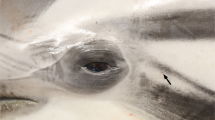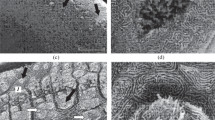Synopsis
Solitary chemosensory cells (SCC) occur in the epidermis of many lower, aquatic vertebrates. By scanning electron microscopy, SCC apices were counted and density distributions estimated along various transects at the head and body of 12 species of teleost fishes, 7 cyprinids, 2 perciforms, 2 catfish and 1 characinid. In contrast to taste buds (TB), the distribution of SCCs is relatively even, with slightly higher densities at the forehead and along the dorsal trunk. In most species 1000 to 1500 SCC apices per mm2 of skin were counted. Considerably higher densities occur in halos around free neuromasts. Depending on fish size and apex density, the epidermis of individuals may contain millions of SCCs. SCCs are considerably more abundant in individual fish than TB sensory cells. Highest average SCC densities (2000–4000 per mm2) were found in the cyprinids, roach, nase, chub and bream. Lowest densities (250 per mm2) occurred in the neon tetra. No correlations could be found between SCC densities and TB densities or relative size of the brain stem facial lobe, supporting the view of different functions and biological roles of the SCC and the TB systems. Whether teleost SCCs generally respond to mucoid substances, as in the case of the rocklings, remains an open question.
Similar content being viewed by others
References cited
Baatrup, E. & K.B. Doving. 1985. Physiological studies on solitary receptors of the oral disc papillae in the adult brook lamprey,Lampetra planeri (Bloch). Chem. Sens. 10: 559–566.
Bardach, J.E. & J. Atema. 1971. The sense of taste in fishes. pp. 293–236. In: L.M. Beidler (ed.) Handbook of Sensory Physiology 4, Springer-Verlag, Berlin.
Bardach, J.E. & J. Case. 1965. Sensory capabilities of the modified fins of squirrel hake (Urophycis chuss) and searobins (Prionotus carolinus andP. evolans). Copeia. 1965: 194–206.
Berri, R., R. Vezzosi & A. Ercolini. 1989. Locomotory response ofPhreatichthys andruzzi Vinciguerra (Pisces, Cyprinidae) to chemical signals of conspecifics and closely related species. Experientia 45: 205–207.
Brandstätter, R. & K. Kotrschal. 1990. Brain growth patterns from juveniles to adults in four mid-European cyprinid fishes (Cyprinidae, Teleostei), roach (Rutilus rutilus), bream (Abramis brama), carp (Cyprinus carpio) and sabre-carp (Pelecus cultratus). Brain, Behav. Evolut. 35: 195–211.
Caprio, J. 1988. Peripheral filters and chemoreceptor cells in fishes. pp. 313–338. In: J. Atema, R.R. Fay, A.N. Popper & W.N. Tavolga (ed.) Sensory Biology of Aquatic Animals, Springer-Verlag, New York.
Finger, T.E. 1982. Somatotopy of the representation of the pectoral fin and free fin rays in the spinal cord of the sea robin,Prionotus carolinus. Biol. Bull. 163: 154–161.
Finger, T.E. 1989. Sensorimotor mapping and oropharyngeal reflexes in goldfish. Chemorec. Abstr. 17: 6.
Frisch, von K. 1941. Über einen Schreckstoff der Fischhaut und seine biologische Bedeutung. Z. vgl. Physiol. 29: 46–145.
Gomahr, A., M. Palzenberger & K. Kotrschal. 1992. Density distribution of external taste buds in cyprinids. Env. Biol. Fish. 33: 125–134.
Herrick, C.J. 1904. The organs and sense of taste in fishes. U.S. Fish. Comm. Bull. 22: 239–272.
Herrick, C.J. 1906. On the centers for taste and touch in the medulla oblongata of fishes. J. Comp. Neurol. Psychol. 16: 403–439.
Jakubowski, M. & M. Whitear. 1986. Ultrastructure of taste buds in fishes. Folia Histochem. Cytobiol. 24: 310–311.
Jakubowski, M. & M. Whitear. 1990. Comparative morphology and cytology of taste buds in teleosts. Z. mikrosk.-anat. Forsch. 104: 529–560.
Kinnamon, J.C. 1987. Organization and innervation of taste buds. pp. 277–298 In: T.E. Finger & W.L. Silver (ed.) Neurobiology of Taste and Smell, J. Wiley, New York.
Kiyohara, S., S. Yamashita & J. Kitoh. 1980. Distribution of taste buds on the lips and inside the mouth in the minnow,Pseudorasbora parva. Physiol. Behav. 24: 1143–1147.
Kiyohara, S., I. Hidaka, J. Kitoh & S. Yamashita. 1985. Mechanical sensitivity of the facial nerve fibers innervating the anterior palate of the puffer,Fugu pardalis, and their central projection to the primary taste center. J. Comp. Physiol. A 157: 705–716.
Kotrschal, K. & H. Junger. 1988. Patterns of brain morphology in mid-European Cyprinidae (Pisces, Teleostei): a quantitative histological study. J. Hirnforsch. 29: 341–352.
Kotrschal, K. & M. Whitear. 1988. Chemosensory anterior dorsal fin in rocklings (Gaidropsarus andCiliata, Teleostei, Gadidae): somatotopic representation of the ramus recurrens facialis as revealed by transganglionic transport of HRP. J. Comp. Neurol. 268: 109–120.
Kotrschal, K., M. Whitear & H. Adam. 1984. Morphology and histology of the anterior dorsal fin ofGaidropsarus mediterraneus (Pisces, Teleostei), a specialized sensory organ. Zoomorphol. 104: 365–372.
Kotrschal, K., J. Atema & R. Peters. 1989. A novel chemosensory system in fish: do rocklings (Ciliata mustela, Gadidae) use their solitary chemoreceptor cells as fish detectors? Biol. Bull. 177: 328.
Lane, E.B. & M. Whitear. 1982. Sensory structures on the surface of fish skin. I. Putative chemoreceptors. Zool. J. Linn. Soc. 74: 141–141.
Marui, T. & J. Caprio. 1982. Electrophysiological evidence for the topographical arrangement of taste and tactile neurons in the facial lobe of the channel catfish. Brain Res. 231: 185–190.
Peters, R.C., G.W. van Steenderen & K. Kotrschal. 1987. A chemoreceptive function for the anterior dorsal fin in rocklings (Gaidropsarus andCiliata: Teleostei: Gadidae): electrophysiological evidence. J. Mar. Biol. Ass. U.K. 67: 819–823.
Peters, R.C., K. Kotrschal, W.-D. Krautgartner & J. Atema. 1989. A novel chemosensory system in fish: electrophysiological evidence for mucus detection by solitary chemoreceptor cells in rocklings (Ciliata mustela, Gadidae). Biol. Bull. 177: 329.
Peters, R.C., K. Kotrschal & W.-D. Krautgartner. 1991. Solitary chemoreceptor cells ofCiliata mustela (Gadidae, Teleostei) are tuned to mucoid stimuli. Chem. Sens. 16: 31–42.
Reutter, K. 1986. Chemoreceptors. pp. 586–604. In: J. Bereiter-Hahn, A.G. Matoltsy & K.S. Richards (ed.) Biology of the Integument, 2 Vertebrates, Springer-Verlag, Berlin.
Schiemer, F. 1985. Die Bedeutung der Augewässer als Schutzzonen für die Fischfauna. Österreichs Wasserwirtschaft 37: 239–245.
Schiemer, F. 1988. Gefährdete Cypriniden — Indikatoren für die Ökologische Intaktheit von Fluβsystemen. Natur und Landschaft 63: 370–373.
Schulte, E. & A. Holl. 1972. Feibau der Kopftentakel und ihrer Sinnesorgane beiBlennius tentacularis (Pisces, Blenniiformes). Mar. Biol. 12: 67–80.
Sibbing, F.A. 1988. Specializations and limitations of utilization of food by carp,Cyprinus carpio: a study of oral food processing. Env. Biol. Fish. 22: 161–178.
Silver, W.L. 1987. The common chemical sense. pp. 65–87. In: T.E. Finger & W.L. Silver (ed.) Neurobiology of Taste and Smell, J. Wiley, New York.
Silver, W.L. & T.E. Finger. 1984. Electrophysiological examination of a non-olfactory, non-gustatory chemosense in the searobin,Prionotus carolinus. J. Comp. Physiol. A 154: 167–174.
Todd, J.H., J. Atema & J.E. Bardach. 1967. Chemical communication in social behavior of a fish, the yellow bullhead (Ictalurus natalis). Science 158: 672–673.
Whitear, M. 1952. The innervation of the skin of teleost fishes. Q. J. Microsc. Sci. 93: 298–305.
Whitear, M. 1965. Presumed sensory cells in fish epidermis. Nature 208: 703–704.
Whitear, M. 1971. Cell specialization and sensory function in fish epidermis. J. Zool. (Lond.) 163: 237–264.
Whitear, M. 1976. Identification of the epidermal ‘Stiftchen-zellen’ of frog tadpoles by electron microscopy. Cell Tissue Res. 175: 391–402.
Whitear, M. 1991. Solitary chemoreceptor cell. In: T.J. Hara (ed.) Chemoreception in Fishes (in press).
Whitear, M. & K. Kotrschal. 1988. The chemosensory anterior dorsal fin in rocklings (Gaidropsarus andCiliata, Teleostei, Gadidae): activity, fine structure and innervation. J. Zool. (Lond.) 216: 339–366.
Whitear, M. & E.B. Lane. 1983. Oligovillous cells of the epidermis: sensory elements of lamprey skin. J. Zool. (Lond.) 199: 359–384.
Author information
Authors and Affiliations
Rights and permissions
About this article
Cite this article
Kotrschal, K. Quantitative scanning electron microscopy of solitary chemoreceptor cells in cyprinids and other teleosts. Environ Biol Fish 35, 273–282 (1992). https://doi.org/10.1007/BF00001894
Received:
Accepted:
Issue Date:
DOI: https://doi.org/10.1007/BF00001894




